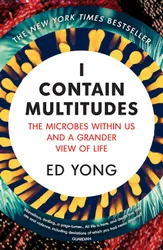In many ways, this book does for bacteria what Entangled Life does for fungi. It explores and examines the symbiotic relationships that exist between microbes and other organisms. It starts by discussing how microbes were first noticed by a Dutch scientist called Anthony van Leeuwenhoek, who was peering through an early version of a microscope of his own design. It’s fun to imagine how strange it must have seemed to first realise that there were trillions of tiny organisms living everywhere, unseen by the naked eye. As it became understood that disease was often caused by microbes, humans began to try to rid their world of disease by killing them. This included the antiseptics used to make surgery safer, and the development of antibiotics. In recent years though, scientists have begun to realise how important microbes are to many different creatures, including ourselves. This book aims to cover what we currently understand about the bacteria that make their homes in and on our bodies, and those of other creatures.
We learn about how communities of bacteria form within the guts of animals. These can be initialised at birth from the birth canal of the mother, and encouraged through the inclusion of special food which is only for the bacteria (what we sometimes call pre-biotics) in the milk of mammals. Other creatures share bacteria within their communities by eating each other’s faeces. The book also covers the (slightly less disgusting) possibilities that humans have developed via faecal transplants to help resolve digestive problems caused by out of control microbiomes.
There are some fascinating case studies of animals (including humans) who have developed new abilities as a result of bacteria that they have acquired and become symbiotic with. This includes new food sources that can be digested as a result of gut bacteria that can break down substances that the animal can’t eat on its own. It also includes toxins manufactured by bacteria, that an animal can use in self-defence, and light that is produced by phosphorescent bacteria within certain types of squid, used for camouflage when seen from below against a light sky.
Our understanding of the bacteria in our guts (and elsewhere) has been greatly enhanced in recent years by improvements in DNA sequencing. Previously, individual bacteria had to be cultivated in a lab in order to identify them, and this wasn’t always possible given the different conditions in a lab versus the natural habitat of the bacteria. Now the genomes of bacteria in a sample, such as from the gut of an animal, can be analysed and identified quickly. This allows many more strains to be identified.
Another aspect that has been revealed is how readily bacteria swap genes between themselves, gaining new abilities that help them survive and thrive. Reading about this, it reminded me of the gene’s eye view of evolution has described in The Selfish Gene. It really shows that the gene is the unit of selection and survival, not the bacteria. If the gene can survive better in cooperation with the genes in a different bacterium, then it can and will do so. There are even cases that have been found of bacterial genes becoming part of the organism that originally hosted the bacteria.
Overall I found this book a fascinating exploration of the world of symbiotic bacteria. It covers a wide range of topics and I learned a lot about how crucial these invisible organisms are to how the natural world operates.
